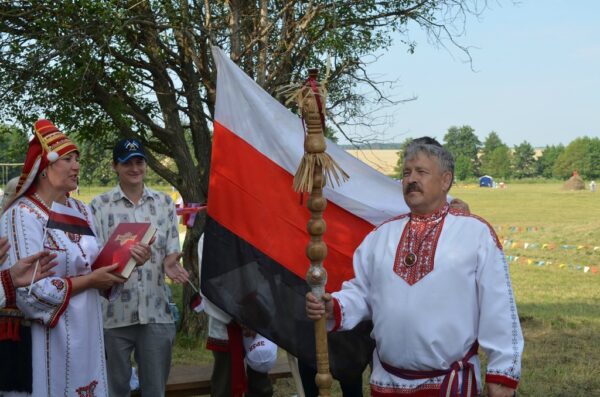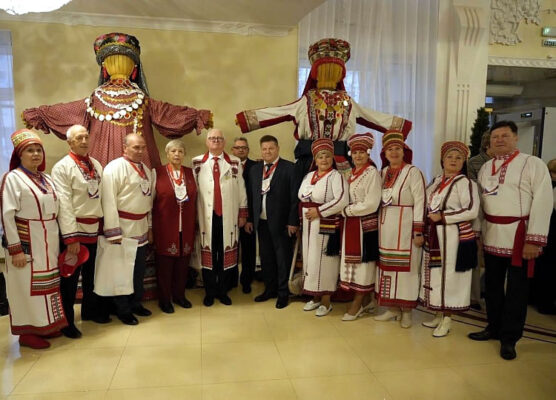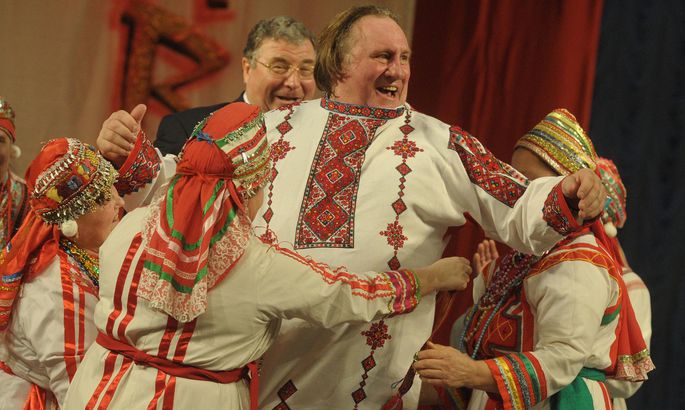
Mordvins
ERZYA AND MOKSHA
Names
The Russian ethnonym mordva has been used as a common name for the Erzya and Moksha. Through the Russian language this practice has spread to other languages. The term is of unclear origin. However, when examining the word etymologically, the word contains the stem mord that could very well be an Indo-Iranian loan from a hypothetical stem *morda, with the v in the Russian name being secondary. Yet, the word itself has not been attested from either Erzya or Moksha. The term mordva is, therefore, an exonym, and perceived by many Erzya and Moksha as derogatory.
The common practice in English is to use the term Mordvin to denote both the Erzya and the Moksha. The term for the titular administrative unit for the Mordvins is called the Republic of Mordovia. A derivative of this term is Mordovian, which refers to an inhabitant of the Republic of Mordovia. It is worth noting that in recent times, the official Russian use has favoured the term мордовский in stead of мордва, even when the context would translate in English as ‘Mordvin’. Such a use of language indicates that the Russian officials wish to conflate Mordvins with their titular republic and to disregard that the majority of Mordvins, especially Erzya live outside the Republic of Mordovia.
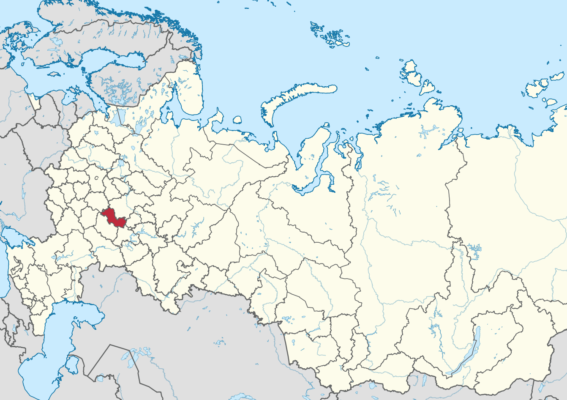
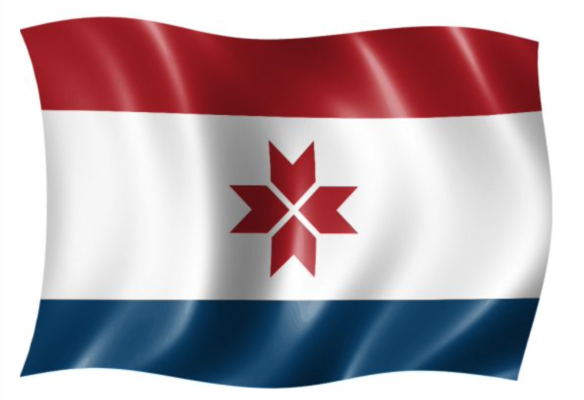
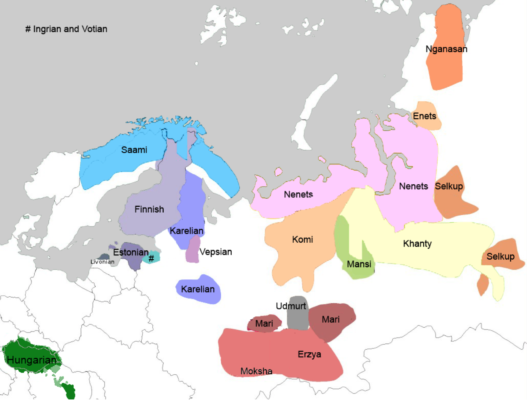
Territory
The Mordvins have their nominal republic within the Russian Federation, the Republic of Mordovia. The Republic first took shape in 1928 as the Mordvin Okrug. Two years later, the status of the administrative region was changed to the Mordvin Autonomous Oblast under Kuybyshev Krai (nowadays Samara Oblast). In 1934, the krai was changed to an oblast, and the Mordvin Autonomous Oblast became the Mordvin Autonomous Soviet Socialist Republic under the Russian SFSR. In 1990, the legal status of the republic was changed to that of the Mordovian Soviet Socialist Republic. The republic’s name was change to that of the Republic of Mordovia in 1994. The capital of the Republic of Mordovia is Saransk.
Administratively, the Erzya live in the eastern part of the Republic of Mordovia, in Nizhny Novgorod and Ulyanovsk Oblasts, as well as in Bashkortostan, Tatarstan and Chuvashia. The Moksha live in the southern and western parts of the Republic of Mordovia and in Pensa and Saratov Oblasts.
Population
The relative distribution of the overall Mordvin population has been traditionally regarded to be two thirds Erzya, one third Moksha. The 1926 All-Russian census distinguished between the Erzya and Moksha, and the current concensus among researchers of the Mordvin peoples concurs with this estimate. More specific statistics are difficult to obtain, because following censuses have mainly grouped the Erzya and Moksha under the term ‘Mordvin’.
Together, the Mordvins are among the largest Finno-Ugric peoples, In 2002, the Mordvins were the 8th largest ethnic group of the Russian Federation. According to the 2002 census, there were 843,359 Mordvins of whom 73% spoke their mother tongue. Of them, 84,407 self-identified as Erzya and 49,624 as Moksha.
By the following census, the Mordvin population had fallen to be the 9th largest ethnic group of the Russian Federation. According to the 2010 census there were 744,236 Mordvins. Of those, 57,008 specified their ethnicity as Erzya and 4,767 as Moksha. Language competence decreased with 392,941 reported speakers of Mordvin. In addition, there were 36,726 speakers of Erzya and 1,529 speakers of Moksha.
According to the 2021 census, the Mordvin population had still fallen to be the 16th largest ethnic group of the Russian Federation. In total according to the census, there were 484,450 Mordvins. Of those, 50,086 self-identified as Erzya and 11,801 as Moksha. Noteworthy is that the amount of self-identified Moksha increased by 147,6% from the previous census. Language competence of Mordvin had decreased to 220,090 speakers. Yet, there were 40,045 speakers of Erzya and 19,911 speakers of Moksha.
In 1989, the Mordvin population in the same territory was much larger – 1,072,939. Erzya and Moksha are assimilating faster than other Finno-Ugrians, largely due to their geographic dispersion. In the Republic of Mordovia, they make up only a third of the overall population. The greatest number of Mordvins live in Samara, Pensa, Orenburg, Ulyanovsk and Nizhny Novgorod Oblasts. Outside the Russian Federation, there are many Mordvins in Kazakhstan (30,000), Ukraine (19,000) and Uzbekistan (12,000).
Languages
The Erzya and Moksha languages belong to the Mordvinic branch of Uralic languages. The Mordvinic languages are nowadays grouped with the Finnic and Saami languages within the West Uralic languages. Previously, the Mordvinic languages were grouped within the Volgaic languages along with Mari and the extinct languages Merya and Murom, but the most recent research indicates that West Uralic languages share linguistic features with each other that descend form a common proto-language. At the same time, similarities between Mordvinic and Mari languages are due to close contacts for centuries.
The Mordvinic languages began to diverge from West Uralic before 1000 BC, when the speakers of Proto-Finnic and Proto-Saami migrated westwards and northwestwards, respectively. The western reach of Proto-Mordvinic extended to areas, where Baltic languages were spoken. There are some Baltic loanwords in the Mordvinic languages that show prehistoric contacts between the languages.
Erzya and Moksha are as similar to each other as Estonian is to Finnish. Moksha has relatively more Persian and Turkic influences than Erzya.
The Erzya and Moksha written languages began forming at the end of the 19th century. An official standardised written language was completed for the Erzya language in 1925 and for the Moksha language in 1933. Both written languages are based on the Cyrillic alphabet.
According to the consitution of the Republic of Mordovia, the republic has three official languages: Russian, Erzya and Moksha. The official status of the latter two is nonetheless a formality and in reality they have very little weight in public life and education.
History
The Erzya and Moksha are indigenous peoples of the Central Volga area. Their original territory was much wider, to the Upper Volga area in the west and to the River Volga in the north. The core territory of the Erzya was more to the north, in the southern part of today’s Nizhny Novgorod Oblast while the Moksha lived in the territory of today’s Republic of Mordovia, as well as to its west and south.
The Mordvin territories began contracting at the end of pre-historic times under pressure from Eastern Slavs from the west and Bulgars from the east. Eastern Mordvins were brought under the influence of Volga-Kama-Bulgar probably starting from the end of the 10thcentury. Western Mordvins had to respond to Russian expansionist efforts after the end of the 11th century. In 1080, Russians erected Murom Castle on the River Oka and in 1221, Nizhny Novgorod was established. Mordvin lands were increasingly infiltrated by Russian settlers.
In 1230, however, Mordvin territories were invaded by Mongols and these lands were annexed to the Golden Horde. With the weakening of the Golden Horde, the Russian influence from the north and west gradually strengthened and colonisation of farmers picked up speed. The Erzya began resettlement to the east and southeast from the Moksha. Moksha territory remained at first under the Kazan Khanate – one of the heirs of the Golden Horde. Moksha aristocrats maintained a certain autonomy.
By the middle of the 16th century, the entire Mordvin territory came under the control of Moscow. Mordvin lands were allocated to Russian aristocrats and monasteries, peasants were placed under serfdom. In the 17th century, the Russian rule gradually shifted to the forest steppe areas which was followed by southward resettlements of Russian and Mordvin peasants.
Forced baptism of Mordvins who until now had mostly kept their animist religion took place in the first half of the 18th century. Many Mordvins resettled in the 18th-19th centuries to steppe areas annexed by Russia on the other side of the River Volga. In their traditional territory they remained a minority, while the role of the Russian language and mixed marriages increased.
In the 19th century, Mordvins were largely an illiterate peasant folk whose one-time upper-class had long ago dissolved. At the end of the 19th century, Mordvin written languages began to be developed as part of the Ilminsk system and a small Mordvin intelligentsia that was interested in folk customs and culture emerged. The most outstanding Mordvin intellectual of the first generation was Makar Yevseyev (1864-1931).
Mordvins gained their own autonomous territory relatively late given that there was no concrete core area based on which it could be formed. Still, the Mordovian region was established in 1928, which in 1930 was reorganised into an autonomous oblast and in 1934 into an autonomous soviet socialist republic (ASSR) under the Russian SFSR.
Collectivisation of agriculture hit traditional peasants relatively hard. In the 1930s, represssions against Mordvin intellectuals were perpetrated. Since the end of the 1950s, the positions of Mordvin languages in public life, media and educational life began to deteriorate. The Erzya and Moksha languages were effectively given the status of the collective farmers’ home language. In schools, the Mordvin languages were taught only in the first grades (mostly, in the countryside) and written word in these languages had become less frequent than before World War II.
Modern Times
The breakup of the Soviet Union gave rise to a certain national reawakening among the Mordvins. In the autumn of 1989, mostly Erzya intellectuals initiated an organization resembling Estonia’s Rahvarinne (National Front) called Mastorava (Mother Earth). In 1991, a society Vaigel’ (Voice) for the promotion of Mordvin culture and language was established at the University of Mordovia.
In March 1992, the 1st Congress of Erzya and Moksha peoples was assembled, which witnessed tensions between the Erzya and Moksha. The Erzya were more active and radical and accused the Moksha of being too passive and conciliatory.
In 1993, separate Erzya organisations Erzjan’ Mastor (Erzya Land) and Erzjava (Erzya Mother) were established. The Erzya diaspora was activated. The Erzya were not satisfied with the joint ethnonym ‘Mordvin’ and with its usage in the name of the republic. The ethnic Russian leadership of the republic was also considering renaming the Mordovian ASSR into simply Saransk Oblast and thus getting rid of the national autonomy altogether. The Mordovian ASSR was declared the Republic of Mordovia only in 1994.
Beliefs
Religious Mordvins are mostly Russian Orthodox. There is also a small number of Old Believers among Mordvins. Atheism was widespread in the 20th century, while towards the end of the century several new religions were introduced.
Starting from the late 1980’s and early 1990’s, the Erzya cultural intelligentsia has started reviving the pre-Christian Erzya religion as marker of the Erzya identity. The revival of the pre-Christian religion of the Erzya is centred around Rasjken Ozks ‘national prayer’. The all-Erzya prayer was banned by decree of Tsar Michael I in 1629, but revived in 1999, after 370 years.
